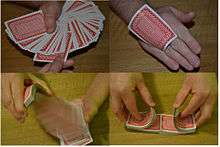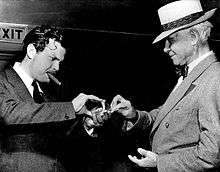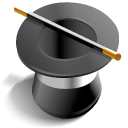Card manipulation

Card manipulation is the branch of magical illusion that deals with creating effects using sleight of hand techniques involving playing cards. Card manipulation is often used in magical performances, especially in close-up, parlor, and street magic. Some of the most recognized names in this field include Dai Vernon,[1] Tony Slydini,[2] Ed Marlo, S.W. Erdnase, Richard Turner, John Scarne and Ricky Jay. Before becoming world-famous for his escapes, Houdini billed himself as "The King of Cards".[3]
History

Playing cards became popular with magicians in the last century or so as they were props which were inexpensive, versatile, and easily available. Although magicians have created and presented myriad of illusions with cards (sometimes referred to as tricks), most of these illusions are generally considered to be built upon perhaps one hundred or so basic principles and techniques. Presentation and context (including patter, the conjurer's misleading account of what he is doing) account for many of the variations.
Card magic, in one form or another, likely dates from the time playing cards became commonly known, towards the second half of the fourteenth century, but its history in this period is largely undocumented. Compared to sleight of hand magic in general and to cups and balls, it is a relatively new form of magic.[4] However, due to its versatility as a prop it has become very popular amongst modern magicians.
Martin Gardner called S.W. Erdnase's 1902 treatise on card manipulation Artifice, Ruse and Subterfuge at the Card Table: A Treatise on the Science and Art of Manipulating Cards[5] "the most famous, the most carefully studied book ever published on the art of manipulating cards at gaming tables".[6]
Technique
Illusions performed with playing cards are constructed using basic card manipulation techniques (or sleights). It is the intention of the performer that such sleights are performed in a manner which is undetectable to the audience—however, that result takes practice and a thorough understanding of method.[7] Manipulation techniques include:
Lifts
Lifts are techniques which extract one or more cards from a deck.[8] The produced card(s) are normally known to the audience, for example having previously been selected or identified as part of the illusion. In sleight of hand, a "double lift" can be made to extract two cards from the deck, but held together to appear as one card.
False deals
Dealing cards (for example at the start of a traditional card game) is considered a fair means of distributing cards. False deals are techniques which appear to deliver cards fairly, when actually the cards delivered are predetermined or known to the performer. False dealing techniques include: second dealing, bottom dealing, middle dealing, false counts (more or less cards are dealt than expected), and double dealing (the top and bottom cards of a small packet are dealt together).[9]
Side slips
A technique generally used to bring a predetermined card to the top of a deck, or the second card from the top of the deck. Depth-perception plays a key role, since it is obvious where card placement happens otherwise. One of such techniques is known as the Marlo tilt.
Passes
The effect of the card pass is that an identified card is inserted somewhere into a deck. However, following rapid and concealed manipulation by the performer, it is then revealed to be on the top (or bottom) of the deck. A pass is achieved by swapping the portion of the deck from the identified card downwards, with the portion of the deck above the identified card. Pass techniques include: the invisible turn-over pass, the Zingone Perfect Table pass, the flesh grip pass, the jog pass, the Braue pass, the Charlier pass, the finger palm pass[10] and the Hermann pass. Simply, a card pass is a secret cut of the deck (not to be confused with a coin pass which is a false transfer of a coin from one hand to the other).
Palming
Palming is a technique for holding or concealing one or more cards. Cards palmed from a deck are typically held in reserve (unseen by the audience) until production is required for the illusion being performed. Palming techniques include: the Braue diagonal tip-up, the swing, the thumb-count, face card palm, the crosswise, new vertical, the gamblers' squaring, the gamblers' flat, the Hugard top palm, the flip-over, the Hofzinser bottom, the Braue bottom, the Tenkai palm and the Zingone bottom.[11]
False shuffles
Shuffling cards is considered a fair means to randomize the cards contained in a deck. False shuffles are techniques which appear to fairly shuffle a deck, when actually the cards in the deck are maintained in an order appropriate to the illusion being performed. False shuffles can be performed that permit one or more cards to be positioned in a deck, or even for the entire deck to remain in an unshuffled state (for example the state the deck was in before the shuffle). False shuffle techniques include: the perfect riffle, the strip-out, the Hindu shuffle, the gamblers', and various stock shuffling techniques (where the locations of one or more cards are controlled during the false shuffle).[12]
False cuts
Cutting a deck of cards is a technique whereby the deck is split into two portions (the split point being randomly determined – often by a member of the audience), which are then swapped – the effect being to make sure that no one is sure of which card is on the top of the deck. False cuts are techniques whereby the performer appears to organise a fair cut, when actually a predetermined card (or cards) is organised to be located on the top of the deck. False cutting techniques include: the false running cut, and the gambler's false cut.[13]
Color Change
A Color Change is the effect of changing one card to another in front of the spectators eyes. There are many different techniques to accomplish this effect, but among the most popular are the classic color change and the snap change. Separating red and black cards is a variation of the "sensitive fingertips" trick.[14]
Crimps
Crimps are techniques whereby part of a card is intentionally physically marked, creased, or bent to facilitate identification during an illusion. Crimp techniques include: the regular crimp, the gamblers' crimp, the breather crimp and the peek crimp.[15]
Jogs
A jog is one or more cards which protrude slightly from somewhere within a deck or stack of cards. The protrusion, although not noticeable to the audience, permits the performer to retain knowledge about the location of the card during other manipulations. While jogs are not always hidden from the audience, they are most often. Some varieties include 'in jogs', 'side jogs', and 'out jogs'. [16]
Reverses
Card reverses are techniques whereby one or more cards in a deck are made to change their direction, for example from face up to face down.[17]
Forces
Card forces are the sleight which involves forcing a spectator to choose a card that has been predetermined by the performer, while maintaining supposed free choice. Some forces include; the classic force, the riffle force, and the slip force.
See also
References
Citations
- ↑ Ganson, Lewis. The Dai Vernon Book of Magic, L&L Publishing, First edition, 1994.
- ↑ Ganson, Lewis. The Magic of Slydini, Harry Stanley; First edition, 1960, pp. 2-5.
- ↑ Kalush & Sloman 2006, p. 42.
- ↑ Randi 1992, pp. 17-27.
- ↑ Erdnase 1902.
- ↑ Erdnase 1995, Foreword.
- ↑ Hugard & Braue 1974, p. xxi.
- ↑ Hugard & Braue 1974, pp. 3-11.
- ↑ Hugard & Braue 1974, pp. 12-30.
- ↑ Hugard & Braue 1974, pp. 37-48.
- ↑ Hugard & Braue 1974, pp. 49-64.
- ↑ Hugard & Braue 1974, pp. 65-76.
- ↑ Hugard & Braue 1974, pp. 77-80.
- ↑ Scarne on Card Tricks 0486317153 John Scarne - 2013 "SEPARATING RED AND BLACK CARDS This cute trick, sometimes called “Red and Black,” is a variation of the previous one, but the effect derived is somewhat different and probably more dramatic, merely because it allows more freedom ..."
- ↑ Hugard & Braue 1974, pp. 90-92.
- ↑ Hugard & Braue 1974, p. xxiii.
- ↑ Hugard & Braue 1974, pp. 107-112.
Sources
- Randi, James (1992). Conjuring. New York City, US: St. Martin's Press. ISBN 978-0-312-09771-4.
- Kalush, William; Sloman, Larry (2006). The Secret Life of Houdini: The Making of America's First Superhero. New York City, US: Atria Books. ISBN 978-0-7432-7207-0.
- Erdnase, S.W. (1902). Artifice, Ruse and Subterfuge at the Card Table: A Treatise on the Science and Art of Manipulating Cards. New York, US: Frederick J. Drake.
- Erdnase, S.W. (1995). Expert at the Card Table. The Classic Treatise on Card Manipulation. New York, US: Dover Publications. ISBN 0-486-28597-9.
- Hugard, Jean; Braue, Frederick (1974) [First published 1944]. Expert Card Technique: Close-up Table Magic. New York, US: Dover Publications. ISBN 0-486-21755-8.
External links
- The Royal Road to Card Magic, the definitive text on Card Magic
- Trick Decks Types of Trick Decks
- Magic with Cards Photo Feature, Havana Times, June 22, 2010
- Card Trick Tutorials Free, extensive tutorials for card magic.
